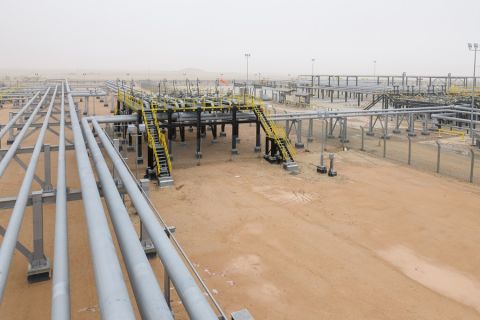Oil and gas producers at times resemble harried, hungry contestants in the TV series "Survivor." Some are feeling the pinch as the commodity cycle goes through a downturn once again and they receive less cash from production than they did last year at this time. In December many were forced to take asset writedowns due to lower commodity prices, which in turn may have affected their bank agreements or sent their stocks lower. Meanwhile, post-Enron, nervous analysts and investors are scrutinizing all energy-industry balance sheets with new vigor. Against this dramatic backdrop, observers are already predicting more consolidation to come as the strong take over the weak. Certainly, this has happened before. When research firm John S. Herold Inc., Norwalk, Connecticut, chronicled the amount of consolidation that has characterized the oil and gas industry, it found that 41 companies were acquired or merged in 2001-and a significant 141 have thus disappeared since 1995. So, to what extent are E&P companies equipped to survive now? Did the prosperity they enjoyed in much of late 2000 and early 2001 enable them to store up financial reserves that will help them withstand the current climate? To find out, Herold analysts Andrew Byrne and Aaron Johnson reviewed the balance sheets and cost structures of 77 North American E&P companies in an attempt to separate the best from the rest, if the price of oil and gas were to fall further this year. The firm developed a worst-case scenario if oil were to fall as low as $15 per barrel and natural gas prices slid below $2 per thousand cubic feet for an extended period of time. It then analyzed which E&P companies still have high costs or too much debt and thus, might need to sell assets-or merge with others-if these worst-case prices came to pass. "Higher cost structures and rising debt levels are putting the crunch on a surprising number of companies," the analysts reported in January. To assess balance-sheet strength Herold used a ratio of net debt to annualized cash flow from the third quarter of 2001 as a measure. As a measure of profitability, it looked at cash cost per barrel of oil equivalent and all-in costs per BOE. The latter includes lease operating expense, DD&A, interest expense, dividends paid on preferred shares and exploration expense. "Cost structures are somewhat dynamic," Herold concedes, " and should decline somewhat along with falling commodity prices, so third-quarter 2001 costs might not be fully representative of future periods. However, we determined that prices realized during this period were a good proxy for current market conditions... "Net-debt-to-annualized-cash-flow ratios show a wide range of indebtedness, from the conservatively financed Canadians at 1.4 times, to the overleveraged small domestic E&Ps at 2.7 times. The obvious conclusion would be that the more conservative Canadians would be in the strongest position to take advantage of an industry pullback." Median figures for the all-in cost metric suggest large and midsize domestic E&P companies would post modest losses at $15 per BOE-but small-caps would "ooze red ink," in Herold's words. The analysts conclude that 81% of the small-caps would lose money and half the mid-sized ones would, if oil fell to $15 per BOE and gas lingered at $2 or less for any period of time. Large and midsize companies would muddle along, but the small domestic E&P companies would suffer the most tumult-and indeed, might need to seek merger partners. Most Canadian companies would still be solidly profitable, the analysts report. Herold ranked the 77 E&P companies in three categories: the strong ones most likely to survive, those that are "in pain" and those "in misery." Any company with a debt-to-cash-flow ratio equal to or greater than 2.5 times is considered to be in pain. A company is in misery if its debt load is equal to or greater than 3.5 times cash flow. Most troubling, Herold found that a significant number of the smaller domestic E&P companies were both high-cost and had high debt. Many ended up relegated to the pain and misery categories. The research firm noted that in general, there is an apparent link between costs and debt-low-cost companies tend to be low-debt companies as well. "We conclude that these traits are a reflection of an expressed conservative management operating philosophy." Herold concludes that these E&Ps are not only most likely to survive, but also could take advantage of the distressed environment as acquirers. The dispersion of survivors among all peer groups in the U.S. and Canada seems to indicate that neither size nor geography plays a dominant role in determining a company's survivability. Rather, it appears to be management's guiding philosophy of conservatism. -Leslie Haines
Recommended Reading
Shipping Industry Urges UN to Protect Vessels After Iran Seizure
2024-04-19 - Merchant ships and seafarers are increasingly in peril at sea as attacks escalate in the Middle East.
Paisie: Crude Prices Rising Faster Than Expected
2024-04-19 - Supply cuts by OPEC+, tensions in Ukraine and Gaza drive the increases.
Report: Freeport LNG Hits Sixth Day of Dwindling Gas Consumption
2024-04-17 - With Freeport LNG operating at a fraction of its full capacity, natural gas futures have fallen following a short rally the week before.
Permian NatGas Hits 15-month Low as Negative Prices Linger
2024-04-16 - Prices at the Waha Hub in West Texas closed at negative $2.99/MMBtu on April 15, its lowest since December 2022.
BP Starts Oil Production at New Offshore Platform in Azerbaijan
2024-04-16 - Azeri Central East offshore platform is the seventh oil platform installed in the Azeri-Chirag-Gunashli field in the Caspian Sea.


